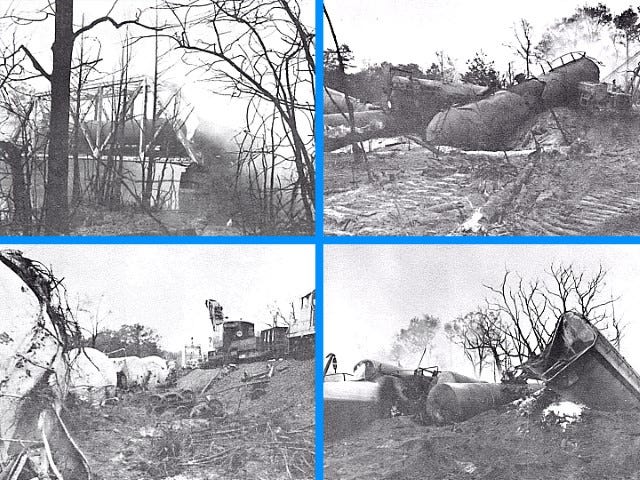
CRESTVIEW — As North Okaloosa County folks awakened April 8, 1979, eastbound Louisville and Nashville Railroad freight train No. 403 rumbled through Milligan.
The five-locomotive, 114-car train slowed as it crossed the Yellow River trestle. At 8 a.m., as the engineer increased speed to climb the 5-mile upgrade into Crestview, the train’s automatic emergency brakes suddenly activated.
“Looking rearward, he saw fire near the cars near the bridge,” a National Transportation Safety Board report stated.
The NTSB determined “a combination of excessive train tonnage and improper train handling” caused a tank car to dislodge the outside rail and derail. Twenty-eight more followed.
The wreck resulted in 4,500 people evacuated, $1,258,500 in property damage, 14 injuries and chemical pollution spilling into the Yellow River.
'A BIG PLUME OF SMOKE'
Ernie Martin — now a Crestview High School educator — was a CHS sophomore living in west Crestview during the train wreck. He and his family were getting ready for church.
“We heard a loud rumble roar. It sounded like thunder but this one shook the house and shook the windows,” Martin said. “We ran outside and, as we looked around, we started seeing a big plume of smoke.
“We grabbed a ladder and climbed up on the roof. That cloud started getting big. It was different colors. It wasn’t like a black cloud from smoke.”
Of 29 derailed cars, 26 were tankers carrying hazardous liquids including anhydrous ammonia, acetone, methyl alcohol, chlorine and carbolic acid.
At 8:03, a derailed ammonia tanker exploded, blowing half the car east and the other half west, and released a vapor cloud. At 8:23, another ammonia tanker blew up.
A fire fueled by leaking acetone and methyl alcohol produced “a white mushroom-type cloud several hundred feet into the air and about 100 feet in diameter,” the NTSB report stated. The fire burned about 60 hours.
WHAT’S ON FIRE?
The Crestview Fire Department met the train’s head brakeman near the Antioch Road crossing. But the engineer’s manifest he presented listed tanker contents by a company code.
Only the conductor in the caboose — a mile away across the Yellow River on the other side of the burning tankers — had the list of which chemicals firefighters would encounter.
Responding agencies also included the Okaloosa County Sheriff’s Office, Okaloosa County Civil Defense, U.S. Environmental Protection Agency, Florida Department of Environmental Regulation, the U.S. Air Force, Army and Coast Guard, and the Department of the Interior Fish and Wildlife Service.
“Communication problems between local agencies and federal and state agencies led to confusion over who was in charge and problems with evacuation security,” the EPA’s report stated.
One politician accidentally contributed to chemical-related injuries. A helicopter carrying then Sen. Lawton Chiles dropped below the safe 500-foot altitude to 250 feet and its downdraft blew venting chlorine gas toward unprotected responders.
EVACUATION
“We kept going up on the roof to see which way the cloud was blowing,” Martin said. “We were going to pre-empt the evacuation if it started shifting our way, but we were lucky and we didn’t have to evacuate.”
One person who did evacuate was now-retired Baker School teacher Roger O’Neal, who recently started his teaching career.
“I remember a lot of people had to evacuate,” O’Neal said. “Someone came by — maybe a sheriff’s posse member — saying it was going to be necessary for us to evacuate. I’m not sure what authorization this person even had.”
Martin said that had the wind shifted, given two-lane evacuation routes, things could’ve turned bad for Crestview.
“That would’ve been quite a lot of people trying to get out and get out in a hurry,” he said. “It would’ve been an adventure to say the least.”
The six-day evacuation order covered Milligan, Baker and all of Northwest Okaloosa County.
“I don’t remember anybody filled with dreaded fear,” O’Neal said. “We had to go to Fort Walton and stay there about a week. You were just inconvenienced for a few days.”
ENVIRONMENTAL DAMAGE
In all, 750 feet of track were destroyed, 1,500 feet were damaged, the trestle’s east approach was destroyed, and the trestle's east end was damaged.
“All trees and ground cover in an area extending 650 feet northwest of the derailment site were defoliated by the ammonia from the vapor cloud,” the NTSB stated.
“I remember about a month later going down to the site and looking at the devastation and seeing how the trees were just burnt to a crisp,” Martin said.
“That whole area, from the bridge back to Antioch Road, was just devoid of life. It took a long time for that area to recover. Even today, if you go down there you can see remnants of the devastation.”
“Hopefully, it was something that the rail companies could learn from to keep that from happening again,” Martin said.
Perhaps they didn’t. Seven months later, another L&N freight derailed in Molina. Again, hazardous chemicals spilled and caught fire.
Email News Bulletin Staff Writer Brian Hughes, follow him on Twitter or call 850-682-6524.
This article originally appeared on Crestview News Bulletin: Remembering the Yellow River train wreck of '79
